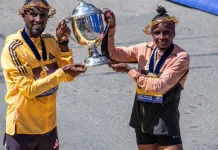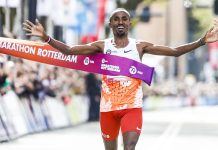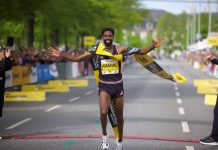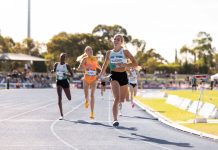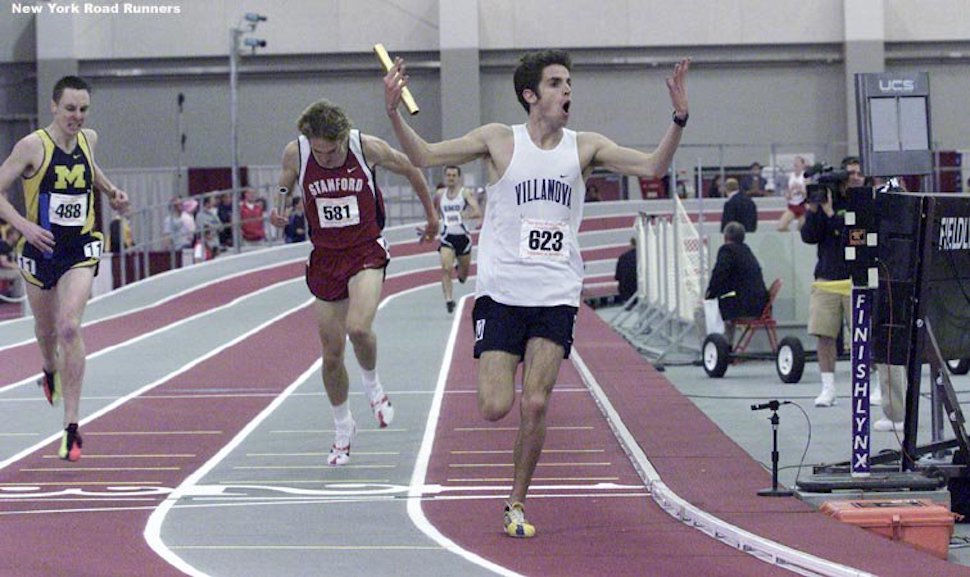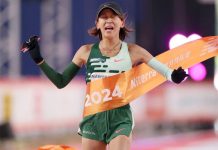The below interview is thanks to Neil MacDonald, who caught up with Adrian Blincoe in January 2004. With Neil’s permission, the interview has been restored so that today’s generation can appreciate this outstanding read.
ADRIAN BLINCOE “KIWI FLYER”
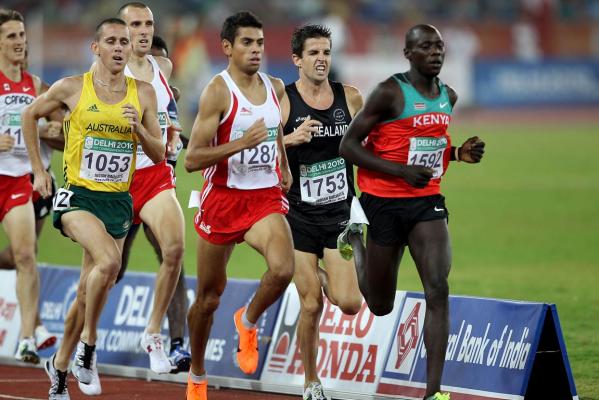
Top New Zealand middle-distance runner, Adrian Blincoe is certainly a seasoned traveller with time spent over the last few years studying in America, racing for the renowned Villanova Wildcats and competing on the European athletic circuit. Over the summer of 2003 / 2004, Adrian travelled to Falls Creek to prepare in his bid to wear New Zealand’s famous black singlet with the silver fern at the Athens Olympics.
N.M. Adrian, welcome to Falls Creek. As a New Zealander, why are you here at this time of the year?
A.B. Just basically to escape the Philadelphia winter which can be very brutal. I remember we had 28 inches of snow in one day so those conditions make running very difficult indeed. Now that I don’t have the restrictions of running for the College, I decided to come over here for seven weeks solid base building training. Because I’ve been in Europe for so long, I just need 10 – 12 weeks of threshold workouts and mileage before I hit the track, so I guess there’s no better place to come than here.
N.M. Have you been to altitude and completed training in a group situation before?
A.B. No, this is the first stint at altitude for me so it’s all kind of new but we have Nic (Bideau) up here with us and he’s been doing this for a long time so he’s giving me advice and altering my workouts to suit how I’m going so that I get the most benefit from my time here.
N.M. How have you enjoyed the different terrain and running trails that Falls Creek has to offer?
A.B. It’s really good. First of all it’s been really good to catch up with the guys that I’ve lived with in Europe, like Georgie (Clarke), Buster (Craig Mottram), Benita (Johnson) and Cam (Benita’s husband). Also, I really like training with Buster, because we push each other along. Last year in Europe I was helping him out when he was coming back from injury and now that I’m not as fit as I’d like to be, he’s helping me out. But our group up here is really good and I’m used to training with up to twenty athletes.
N.M. You completed your first ever ‘Quarters Session” and Langfords yesterday. What were your impressions of this famous session?
A.B. I thought it was going to be a lot easier than it was. When you hear that it’s 8 x 400 metres with a 200 metre ‘float’ between, and then the sort of times that Buster and Mona have run up here, you think that does not sound too hard. But it’s a lot tougher than I thought and I learnt that you can’t ‘cook’ yourself too early. I went out a little too quick at the start and eventually paid for it. However, it’s a good session for me at this time of the year and I’m pretty confident that as I become fitter I can keep dropping my time for the session. I think we’re going to complete this session each Thursday for the next few weeks.
N.M. What was your time yesterday?
A.B. 15.45.
N.M. Coming to a complete stop and then turning at each end point certainly makes the session more difficult. In fact, at Falls Creek it’s a little like a gigantic ‘beep test’.
Ed. At Falls Creek the “Quarters Session” is run along a 600 metre stretch of aqueduct, with a shoe or a jacket or a stick dividing each 200 metre point.
A.B. Yes, I’m not used to doing a session like that and the stopping adds a little time to your end result but it’s the same for everyone. However, the slowing to turn does not mean extra recovery and I was hurting pretty bad towards the end yesterday.
N.M. And, as you said, you probably went out a little hard by sitting on Craig for the first few surges?
A.B. Yes, but it felt easy at that stage. However, once you go over your current fitness level in a session like that at altitude, there’s no coming back. Next time I’ll pace myself a little better early on and I’m confident that I can take a fair bit off my time of 15.45.
N.M. One of the good things about training at Falls Creek is that you have plenty of opportunity for recovering between sessions. What have you been doing between sessions?
A.B. I don’t usually run twice on my hard session day, but up here I’ve been doing an easy run each afternoon, which has been good because I find the easy 30 minute second run freshens up the legs ready for the next day. I have also been heading to the weights room to work on specific strength, stretching and core stability. Apart from that I’ve been fitting in a lot of reading. In the eight days I’ve been here I’ve read five books so that has helped to pass the time while I’m recovering. We’ve also been playing a bit of cards.
N.M. In regards to the cards, I hear that you’re a fan of “Five Hundred”
A.B. Yes, I think it’s the best card game and I’m pretty good at it, if I do say so myself.
N.M. What books have you read so far?
A.B. Lance Armstrong’s second book – “Every Second Counts”, a poker book called “The Greatest Game In The World”, “1984” by George Orwell, plus two of the Narnia series by CS Lewis – I’ve got the whole Narnia Chronicles so I’m working my way through those.
N.M. Pretty varied literary taste, I’d suggest.
A.B. Yes, I like to alternate between a classic book and something a little lighter. I’ve got “The Catcher In The Rye” and “Slaughterhouse Five” up here too, so I plan to read those soon.
N.M. I would have thought you’d have read Salinger’s “Catcher In The Rye” and Orwell’s “1984” at school?
A.B. No, I haven’t. We read a few of the classic American twentieth century novels at school and before heading here I read books like “To Kill A Mockingbird” and the “The Great Gatsby”. Then there was James Joyce’s book ……….. aaahhhh.
N.M. “Ulysses”?
A.B. No ……….. “Portrait Of An Artist As A Young Man” and that was pretty tough reading.
N.M. “Ulysses” is also very tough going?
A.B. Yes, I think “Ulysses” might stay on the shelf for a while.
N.M. I think “Ulysses” holds the record as the book most started but never finished.
A.B. Yes, it’s critically acclaimed and on top of all the “Best Books Of The Twentieth Century” but a very challenging read.
N.M. How did you become involved with Nic Bideau’s group?
A.B. My coach in America, Marcus O’Sullivan is good friends with Nic and so when I’d finished this season in America, he recommended that I work with Nic. When Sonia O’Sullivan was in America for the New York Marathon, we had a meeting and talked things through and now I will be spending the Australian summer training with his group.
(Ed. Marcus O’Sullivan represented Ireland in 4 Olympic Games – 1984 (800, 1500 metres / 1988 (1500 metres) / 1992 (1500 metres) / 1996 (1500 metres). He also won three World Indoor Championships over 1500 metres (1987, 1989, 1993), set the World Record for 1500 metres Indoors in 1989 (3:35.4), ran 3:50.9 for an Indoor Mile and with John Walker and Steve Scott, is one of only three athletes to record 100 plus sub four minute miles.)
N.M. You had a very successful 2003, culminating with you competing at the World Athletic Championships in Paris, where you won a heat of the 1500 metres. Can you go through that race?
A.B. It was kind of funny because, although it was my first senior World Championships, I was not all that nervous because it was not all that difficult to qualify for the next round. In my heat only four runners would not make it through and there were four obvious guys who weren’t up to the standard. Then, Bernard Lagat did not show up for my heat (because of a positive drug test that he was later cleared of) so that made things easier for me. In the race we went out really slow and I felt very comfortable, because I have a good kick and a decent turn of speed. When we started to pick it up I was boxed in right behind Medhi Baala and Reyes Estevez, but that was OK because those sort of guys are going to run on strongly. Then, with 150 metres to go I saw an opening and so that I would have a clear run, I swooped around the outside. With 100 metres to go I was still feeling great so I thought, “I can ease up here and run 0.2 of a second slower or maintain my pace and win the heat?”, so I chose to win the heat. I think it was a good move because, even though it didn’t really mean much, it got a lot of people back home in New Zealand interested.
N.M. Great for the sponsors too?
A.B. Yes, they were very happy.
N.M. Was it front or back page news back in New Zealand?
A.B. It was on the radio a lot and it may have made the small print somewhere in the sports results.
N.M. Was that your biggest win?
A.B. Because of how easy it was going to be to qualify, it was no big deal – The NCAA Championships that I won were a much bigger deal.
N.M. What happened in the World Championships semi-final?
A.B. Aaahhh ……. I got off to a bad start. After only a hundred metres I was boxed in at the rear. You might think that with 1400 metres to go there is plenty of time but when the pack is moving along at 3.36 pace or faster, it is really hard to improve your position unless you’re a sub 3.30 athlete. Then, when the pace picked up, I had the option of running the last 600 metres out in lane three against the best athletes in the world or staying where I was hoping that something would open up on the inside. I chose the later, but no gaps appeared. Then with 300 metres to go I was tripped and lost all momentum. Eventually I came home ninth, which was really disappointing. But I learnt a lot, especially about running the first 100 metres really aggressively so that you’re in the right position. Semi-finals at world level tend to be slow early so you have to be in the lead group when the pace picks up over the last two laps.
N.M. What time did you end up running?
A.B. About 3.42.
(Ed. Adrian’s time was 3:41.53 with Mehdi Baala first in 3:39.73)
N.M. Who was in you semi-final?
A.B. Medhi Baala, Reyes Estevez, Ruiz Silva, Fouad Chouki – the French guy who was later rubbed out for EPO use. There were a lot of guys who’ve run under 3.32.
N.M. Did you stay on in Paris and watch the final?
A.B. Yes, I did. And while it was fantastic to see athletes like El Guerrouj run, I felt that I would not have been out of place in the final. Whereas, two years previously, I would have thought ‘Wow, these guys are really moving – I don’t think I’ll ever reach that level’. So a lot can change over the course of two years.
N.M. Looking through your times, you have run Personal Bests right across the board in 2003.
A.B. Yes, there were P.B.’s in the 800 metres, 1500 metres, mile, 2000 metres and 3000 metres, so it’s been a good year. Basically, it came down to me being a year stronger but also getting into the right races. I’d never been to Europe before and every European race is an opportunity to run fast if you’re in great shape.
N.M. You mentioned earlier that your win in the NCAA Indoor 3000 metres was a highlight. What differences are there from indoor to outdoor racing?
A.B. There’s a lot more contact indoors, it’s a lot tighter on the smaller tracks so you have to protect your space. There can be a lot of elbows thrown but I like that type of physical racing. I won the NCAA 3000 metres and Distance Medley Relay in 2002 also so that was pretty special. When I first came to America my goal was to work my way up into the top three in the college system. In 2001, after six months I had placed second in the indoor 3000 metres, then the following year I recorded the third fastest time ever by a collegian indoors when I ran 7.47. Obviously, going into 2003 I had a fair bit of pressure on me as the favourite for both the 3000 metres and the distance medley but I was able to win both, which was both a relief and very satisfying.
N.M. Would it be fair to say that you receive more recognition in America than you do in New Zealand?
A.B. Absolutely. The famous American magazine “Track and Field News” covers Collegiate Track and Field just as much, if not more, as it covers professional athletics.
N.M. Your impressions of the American College running scene. Is it a great arena to develop running talent?
A.B. For me, it was perfect. I was able to win the New Zealand senior men’s 1500 metres in 2000 but I was only a 3.42 runner at that stage, so I was not ready to compete in the big European races. Instead, I chose to go to Villanova and run with Marcus O’Sullivan. It was a great learning experience for me because I learnt how to race as well as how to just run fast – developing things like my finishing kick and race tactics that I would need if I was going to perform well against the best runners in Europe. I also met a lot a great people as well as having a lot of fun. Saying all of that, you have to be careful in that there are only a handful of universities that I would recommend for runners, because a lot of them are still hung-up on the point scoring syndrome and trying to beat Conference rivals.
N.M. By that, do you mean that some of them flog their athletes and run them into the ground?
A.B. Yes, definitely. But my school was not like that at all. In fact, it was probably the opposite in that if I was feeling tired, they would rest me. For most colleges, the most important meets were the Conference Meets as that’s where the rivalries have developed and where the College Directors decide financial bonuses and structures for coaches. Luckily, Marcus was not at all hung-up on that and would always put the athletes’ well-being ahead of any team wins. I probably only ran 50% of the Conference Meets because our goal was to run well at the NCAA’s and well after I had finished college.
N.M. For anyone interested in going over to America, which Colleges spring to mind as the really good ones as far as athletics is concerned?
A.B. Obviously Villanova, Michigan – that’s where my fellow New Zealand 1500 metre runner, Nick Willis is, Providence is very good, Stanford is good but it’s very hard to get in to because they’re a little anti- foreigner. Colorado, Ohio State, Georgetown – schools like that I’d recommend. But overall, the top three are Villanova, Michigan and Stanford.
Adrian Blincoe anchored Villanova to back-to-back NCAA DMR titles in 2002 (9:31.00) and 2003 (9:29.12) pic.twitter.com/kVBWSJC9j2
— Run Nova (@RunNova) March 16, 2017
N.M. You also ran the World Cross-Country short-course race this year. What was that experience like?
A.B. I have raced the World Cross before, in the mud of Belgium in 2001, so I knew what to expect after finishing 57th. In 2003 I had high expectations and my goal was to finish in the top 30. However, I did not have a great race and finished 41st, which was pretty disappointing. But it’s such a great race and a twelve second improvement would have had me in the top 20, so if you have a good day, a top finish is possible. And so, I’m going back this year, hoping to break into the top 20.
(Ed. Adrian did not race the World Cross – Country in 2004)
N.M. The World Cross – Country is said to be the most competitive race in the world.
A.B. Yes, but not as much as it was with both a short and a long course race now scheduled. But it’s great for me because I can’t run the 12 km. but the 4 km. suits me fine.
N.M. Your plans for 2004? Obviously the Athens Olympics is your top priority.
A.B. Yes, everything I do is working towards Athens but I possibly have a few races here in Australia and maybe a New Zealand race scheduled, depending on my progress in my build-up. Then I will head back to Philadelphia for more training, then onto the World Cross. There’s also a possibility I may race the 3000 metres at the World Indoors. I also want to have a crack at the 5000 metre standard at Mt. Sac. I’m not planning to run the 5000 metres in the Olympics but it would be good to get one under my belt because I haven’t done one since 1998 when I ran 15.20 at the World Junior Championships. Then it’s onto Europe. Nic mentioned heading over in mid May, which is a lot earlier than I’d initially planned but I want to get the 3.36 Olympic Qualifying Time out of the way as soon as possible.
N.M. To make the New Zealand Olympic Team, what do you have to do?
A.B. It’s a bit easier than making the Australian Team in that I just have to run the A Standard – I don’t have to run a trial or the New Zealand Championships which means I can focus on what’s best for me, especially seeing as I’m based in America. So, if I run the A Standard and show good form in the lead-up to the Athens Olympics, I will be selected.
N.M. And, the A Standard is?
A.B. 3:36.2
N.M. You have spent a fair amount of time in London with Craig Mottram, based near Bushy Park. However, this was no luxurious “Five Star Hotel” existence with lots of sleeping on the floor, so the life of a top class athlete is not always as glamorous as it might seem.
A.B. No, the accommodation in London was nothing compared to what we have here at Falls Creek, which is amazing. In London, we had a one bedroom apartment, and Craig and Lauren (Hewitt) had the bedroom and I slept on a mattress in the lounge slash kitchen slash laundry slash dining room, but it was fine because we weren’t there that often with all the travelling to races we were doing. I’m sure an American would have been stressed out with those sort of living conditions but I reckon the Aussies and New Zealanders are a little more hardy. Also, it was close to some really great training venues so it was not a problem at all.
N.M. Did you come across any of the Kenyans while you were training in Bushy Park?
A.B. Yes, but they tend to run earlier than we do. However, you always see them around the streets of Teddington or Kingston, which is where the majority of non-European athletes base themselves.
N.M. You mentioned before that you have a good change of pace. Is that something that comes naturally or have you worked to improve in this area?
A.B. Ummmm …… I haven’t really worked on it that much. However, I do sprint drills and ‘ fast’ strides once a week, and sometimes twice a week during the track season. I do these on a Monday night and Friday night, if I’m doing a second speed session. Although my top end speed might not be as quick as some of the top guys and I would struggle to beat them in a ‘flat out’ 400 metres or 200 metres, I can change gears very quickly – it only takes me a few strides to change from 15 second 100 metre pace to 12 second 100 metre pace.
N.M. A skill that would be very handy in a Championship 1500 metres.
A.B. Yes. As long as you can run the last 300 metres in 38 seconds that’s really all you need because the pace tends to pick up over the last 600 – 700 metres. Because of this, at the top level, you need to be strong too. However, in the New Zealand Championships or in the American Championships, the kick doesn’t usually come until the final 200 metres, so they tend to be different races.
N.M. El Guerrouj has shown that you don’t need to be ‘super quick’ – if you’re running 54-second laps, eventually no one can keep up.
A.B. Exactly.
N.M. What specific sprint drills do you do?
A.B. It’s pretty basic stuff: I do two sets of five different drills. Each of the drills are completed over about 50 metres. The drills are ‘high knees’, ‘skipping and bounding for length and height’, ‘butt kicks’, ‘fast feet’ which is fast, flat-footed small steps concentrating on stepping over my opposite ankle for about 10 metres and “high knees with a kick out at the end” – I think you might call it the “B March”. I do them over slightly longer distances than a sprinter might use. A sprint coach in New Zealand, who coaches my younger brother, suggested that middle distance runners need to do the drills over a longer distance because they need to hold their form for longer.
Then I’ll finish the session off with five or six 100 metre strides with a jog back recovery. I’ll start at 15 second pace and get down to 13 second pace at this time of the year and during the track season, when my fast twitch fibres have kicked in, I’ll be running the last couple of 100 metres at 12 second pace.
N.M. Marcus O’Sullivan is your coach. What is his basic philosophy?
A.B. Most of his philosophy is based on what worked for him. I mean, he went to four Olympics and was at the top of the sport for 16 – 17 years, so he has a wealth of knowledge and experience. One area where he differs from a lot of other coaches is that he does not push you too hard in workouts. Sometimes, you might be struggling in a session and another coach might try to fire you up with, ‘come on, you’ve got to finish these last three reps!’ But if Marcus sees that you’re struggling, he’ll stop the session as there’s no point in thrashing someone who’s already worn down. He really stresses listening to your body. In fact, he did not train me all that hard at all and I’d usually only do 100 kilometres a week. Even the quality workouts aren’t that hard but because you’re absorbing them and fresh for each quality session, you’re improving.
However, one thing I try to do is run my easy runs at a decent pace if I’m feeling good. My father, who was my coach before I went to Marcus, used to emphasize this. In high school I was only running about 50 – 60 kilometres a week whereas some of my competitors were running 100 kilometres or even 100 miles a week so Dad said that if I wanted to be competitive with them, I should complete my basic training runs a little faster.
N.M. Does Marcus still run?
A.B. Yes, he’s still in great shape and often joins in with us. In 2002, at the age of 42, he ran 8.08 for 3000 metres indoors!
N.M. Have you had any injuries?
A.B. After World Juniors I had a patella tendonitis problem that put me out for a whole year and I still have problems with my knees but I know my body very well and I can manage it. Occasionally, I might need to take a week off to let my knees settle down. But if this is the only injury problem I ever have, I’ll be very happy.
N.M. Standing in the freezing Falls Creek water after a run would certainly help your knees?
A.B. It does. When I first arrived in Australia I felt a few twinges in my knees but I’ve been in the cold water a lot up here and they’re feeling good.
N.M. Have you only had your Dad and Marcus O’Sullivan as coaches?
A.B. Yes.
N.M. What were you studying at Villanova?
A.B. Accounting. I actually did two years of accountancy in New Zealand before heading for America. I think accountancy is a great degree to have with travelling as accounting is a universal language and they’re always in demand. Marcus was an accountant too and I have been lucky to pick up a job with a guy that Marcus used to work for. He’s been great in that he allows me to work the hours I want. This is usually about 16 hours a week, made up of four days of 4 hours. I work in the middle of the day, which allows me plenty of time to train but it also means that I have something to do away from running – it’s pretty difficult to be a runner 24 / 7.
N.M. If you were just a runner with all that time to fill in each day, eventually you’d run out of books to read and card playing partners.
A.B. Absolutely.
N.M. New Zealand has a very rich sporting heritage with the All-Blacks, their Cricket and Netball Teams and their champion athletes. What sports did you play while you were growing up?
A.B. Like everyone else, I played rugby. I did this for seven years until I was a little too small and was getting smashed. Apart from rugby, I played cricket, some water polo and basketball. I gave most of those away when I was fifteen and became a bit more serious about running. At seventeen I played a little bit of social water polo. I still swim now – if I become injured, I swim instead of aqua-jogging as I think it’s more beneficial.
N.M. New Zealand’s middle and long distance running has been unbelievably strong with names like Lydiard, Walker, Snell, Halberg, Dixon, Quax and Roe known all over the world. Do any of these people have any influence on New Zealand athletics now?
A.B. A little bit but not as much as you’d expect. Dick Quax and John Davies, who recently passed- away, ran the best athletic meets while I was growing up. John Davies was probably the most influential as he coached a lot of athletes as well as being an administrator in New Zealand. Walker has a bit of influence although it’s more through the people he knows. He’s really good friends with Nic and Marcus and I’m sure both of them have learnt a lot from John. Marcus tells the story of when he started racing in Europe, John asked to see his training diaries and critiqued his training with suggestions like, “you don’t need to be doing this sort of training here” or “why don’t you do this session here?” So in the early years, Walker was the ‘go to guy’ and a huge role model for Marcus. As for Arthur Lydiard, he still does a little coaching and obviously, all the current New Zealand coaches, and most of the coaches from all over the world, use some of Lydiard’s training principles. He still gives talks but he’s into his 80’s now and still very healthy with a forty year old wife.
(Ed. Sadly, in Texas on December 11th 2004, 87 year old Arthur Lydiard died of a heart attack while on an eight week lecture tour of America.)
N.M. Adrian, thank you very much for your time. I hope you enjoy the next few weeks training at Falls Creek and all the very best in your quest to represent New Zealand at the Athens Olympics.
A.B. Thanks Neil.
RUNNER PROFILE
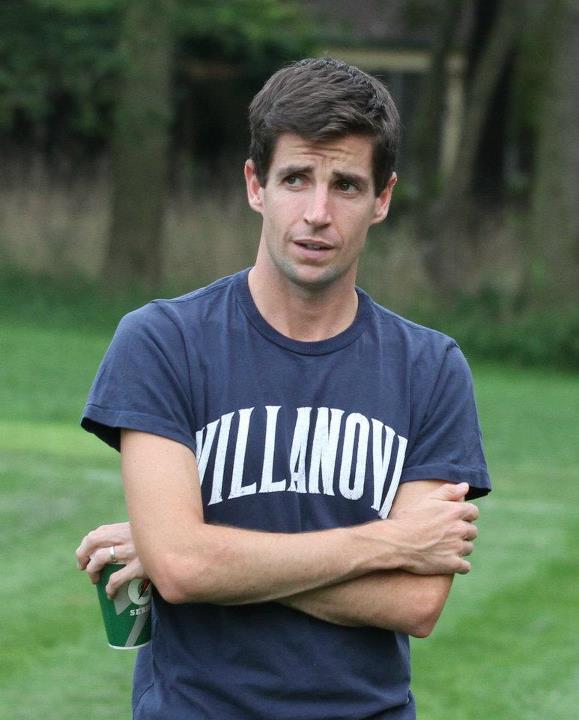
Adrian Blincoe
Occupation Athlete / Accountant School Villanova University – Graduated 2003
Age 24 Date of Birth 4 / 11 / 79
Height 180 cm. Weight 61 kg.
Married / Single Single
Coach Marcus O’Sullivan
Personal Bests
800m. 1:49.81 (improved to 1:48.69 in Solihull – 22 / 5 / 04)
1500m. 3:36.57 (improved to 3:36.53 at the Bergen Bislett Games – 11 / 6 / 04)
Mile 3:54.40
2000m. 4:58.72
3000m. 7:47.46
Favourite Food Indian, Chinese
Food Eaten Before a Race Banana, Muffin Favourite Drink Banana milkshake Favourite Movie “Two Hands”
Favourite Book “Lord Of The Rings” by J.R.R. Tolkien
Favourite Music / Band “Pearl Jam”
Favourite TV Show “24”
Favourite Night Spot “Brownies 23 East” (Philadelphia)
Favourite Holiday Spot “Mt. Manganui”
A Normal Base – Training Week.
|
Mon. |
am. pm. |
30 mins. easy. 30 mins. easy plus drills / strides. |
|
Tues. |
am. |
10 x 1000 metres or 6 x mile @ heart rate – run away from the track. Recovery 45 / 80 seconds or until heart-rate is under 145. In season I would do a track session. |
|
Wed. |
am. |
45 – 60 mins. easy. |
|
Thur. |
am. pm. |
40 mins. easy 30 mins. easy. |
|
Fri. |
am. |
4 – 8 mile tempo run @ 85 % of maximum heart-rate. My maximum heart-rate is 198. In season I would do a track session. |
|
Sat. |
am. |
45 mins. easy. |
|
Sun. |
am. |
75 – 90 mins. steady. |
Note: Easy run pace is about 3:45 minutes / kilometre.
Other Training / Recovery Sessions.
Swimming, weights.
Favourite Training Session 5 x Split 1000’s (600 metres hard / 100 metres jog / 400 metres hard) with 3 minutes recovery between.
Favourite Races 1500 metres and the Distance Medley Relay (1200m. 400m. 800m. 1600m.)
Favourite Place To Train Valley Forge
Toughest Ever Training Session 1600 metres (4.13) 1200 metres (3.00) 800 metres (1.56) 400 metres (54) with a lap jog recovery between.
Most Admired Runners / People Marcus O’Sullivan
Advice to Other Runners “Surround yourself with the best people possible – coach, training partners, friends, manager”
Goals for the Future “To make the 2004 Olympic Final in the 1500 metres.”
Note: Unfortunately, Adrian fell 0.33 of a second short of the Olympic A Standard Qualifying Time and was not selected to represent New Zealand at the Athens Olympics. Instead, New Zealand selected Nick Willis for the 1500 metres.
Twelve months later, Adrian sent the following email:
“I didn’t go to World Cross last year as I got injured (achilles tendonitis) in the last week of January (whilst still up at Falls Creek). I had to take three weeks off completely, and that didn’t leave me enough time to get ready for the race.
Europe last year was disappointing. I came into the season in my best shape, ran a P.B. in my first race – 1:48 for 800 metres. Then I fell in the my first qualifying attempt, next race ran 3:36.5 – just outside the time needed. Then had a couple of slower races: 3:38, 3:37, 3:39 and basically just ran out of steam. It was hard because I was racing every weekend chasing the time, and my training suffered because I was always resting up – thus I ran out of gas a lot quicker than the year before.
This year I want to get back to a similar routine to 2003. I’ll run a few indoor races (I am in Philadelphia right now), then World Cross-Country. Then a few races in the U.S. before meeting up with Nic, Buster, and the crew in London, probably in June. The goal is to run well all season, run World Championships and set myself up for the 2006 Commonwealth Games in Melbourne.
I have actually run 14:18 for 5000 metres as a junior before getting injured. The 15:20 was at World Junior Championships, an embarrassing race brought on by not training due to the knee injury which later put me out for 12 months.
All the best to members to the Geelong Cross-Country Team. Adrian”
Note: Adrian ran the 2005 World Cross – Country Short Course race in Saint Etienne / Saint Galmier, France and finished 69th (12.42) behind the incomparable, Ethiopian, Keninisa Bekele (11.33)
End
Elite Mens Mayoral Mile
Adrian Blincoe 1st 3.57 followed by Campbell of Ireland and Cureen of Samoa all sub 4min.



